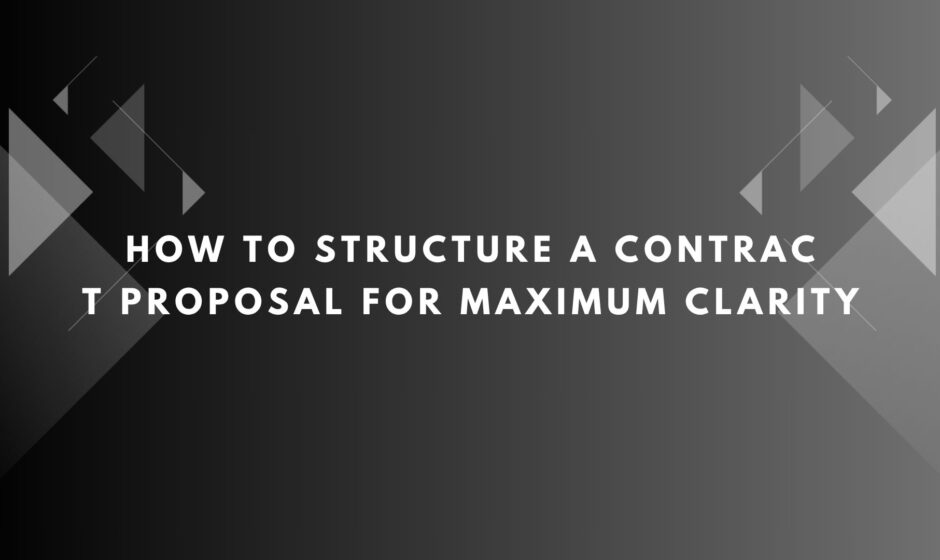When working on AV projects, success is not only about designing great systems and delivering quality installations. It also depends on clear communication with clients from the start — and that begins with your contract proposal. A well-structured contract proposal ensures that both you and your client have the same understanding of the project’s scope, timeline, costs, and responsibilities. Clarity in your proposal reduces the chance of disputes, builds trust, and sets the foundation for a smooth project.
In this blog, we will explore how to structure a contract proposal for maximum clarity and professionalism. Whether you are designing AV systems for a small office or a large venue, following these guidelines will help you present your offer with confidence.
Why Clarity in a Contract Proposal Matters
A contract proposal is often the first formal document that outlines what you are offering to deliver. If it is vague, incomplete, or confusing, it can lead to:
-
Misaligned expectations where the client assumes you will provide something that is not part of the scope.
-
Project delays due to unclear deliverables or timelines.
-
Budget overruns because costs were not defined clearly.
-
Legal disputes if disagreements arise over what was promised.
Designing AV systems involves many technical details, so it is especially important to write proposals that are easy for clients to understand, even if they do not have technical expertise.
Essential Elements of a Clear Contract Proposal
Let’s break down the key sections that every contract proposal should include.
1. Executive Summary
Begin with a brief overview of the project. This section should highlight:
-
The client’s needs or goals as you understand them.
-
A summary of your proposed solution.
-
The value your solution brings to the client.
Keep the language simple and focused on benefits, rather than technical jargon.
2. Scope of Work
This is the heart of your proposal. Describe in detail what you will provide. If you are designing AV systems, for example, specify:
-
The rooms or spaces covered by the design.
-
The type of equipment to be provided (displays, speakers, control systems, cabling, etc.).
-
Services included, such as installation, programming, testing, training, or documentation.
Break down the scope into sections or bullet points so it is easy to read. Be clear about what is not included, if relevant, to avoid assumptions.
3. Project Timeline
Include a schedule that outlines key milestones, such as:
-
Design completion
-
Equipment delivery
-
Installation start and end dates
-
System commissioning
-
Client handover
Providing estimated dates helps manage expectations and allows the client to coordinate their own activities, such as room preparation or IT support.
4. Responsibilities
Clarify who is responsible for what. For example:
-
The client provides site access and necessary utilities.
-
The AV contractor provides equipment, labor, and documentation.
-
Third parties (such as electricians or IT teams) handle specific tasks not in your scope.
Stating responsibilities clearly prevents confusion later.
5. Pricing and Payment Terms
Include a detailed cost breakdown. This might cover:
-
Equipment
-
Labor
-
Programming
-
Travel and expenses
-
Optional items or services
State your payment terms, such as deposits, progress payments, and final payments. Also specify the validity period of the proposal, so the client knows how long they have to accept it.
6. Terms and Conditions
This section protects both you and the client. It should cover:
-
Warranty terms for equipment and workmanship.
-
Conditions for change orders and how additional costs will be handled.
-
Cancellation policies.
-
Liability limitations.
Consult a legal professional to ensure your terms are fair and enforceable.
7. Acceptance Page
Include a signature block where the client can formally accept the proposal. This makes it easy for them to approve the contract without needing to create a separate document.
Tips for Structuring a Clear Proposal
Here are some best practices to follow when writing your proposal.
Use Plain Language
Avoid excessive technical jargon or abbreviations that your client may not understand. When describing complex systems or processes, use clear language or include simple diagrams to illustrate your points.
Format for Readability
Use headings, bullet points, and tables to organize information. Long paragraphs can overwhelm readers. A well-formatted document looks more professional and is easier to review.
Provide Visual Aids
If you are designing AV systems, include basic drawings, flow diagrams, or equipment lists as part of the proposal. Visuals help clients grasp what you are offering.
Be Specific
Vague statements like “provide sound system” can lead to problems. Instead, specify “provide and install two ceiling speakers, amplifier, and wireless microphone system as shown in attached diagram.”
Address Potential Questions
Think about what questions the client might have and address them in your proposal. This could include information on support after installation, training provided, or how you will handle unexpected site conditions.
Example Structure of a Contract Proposal
Here is a simple outline you can follow:
-
Cover Page
-
Project title
-
Client name
-
Your company name
-
Date
-
-
Executive Summary
-
Scope of Work
-
Project Timeline
-
Responsibilities
-
Pricing and Payment Terms
-
Terms and Conditions
-
Acceptance Page
-
Appendices
-
Drawings
-
Equipment lists
-
Additional documentation
-
Conclusion
A clear, well-structured contract proposal not only protects your business but also helps you win client trust and approval. By following the structure outlined above, you can ensure that your proposals communicate your offer effectively, reduce the risk of misunderstandings, and set your project up for success. Whether you are designing AV systems for a small office or a large-scale venue, clarity in your contract proposal is one of the most valuable tools you have.




Before & After: Real-Life Contract Proposal Makeover Examples - Repur Tech 4 Jul 2025
[…] Read more: https://fastpanda.in/2025/07/04/how-to-structure-a-contract-proposal-for-maximum-clarity/ […]